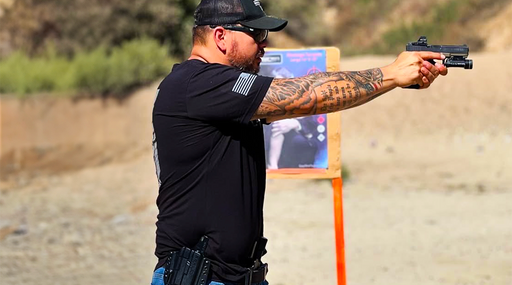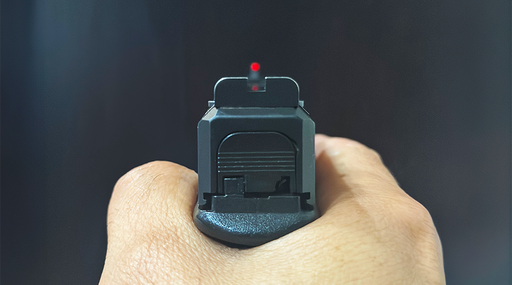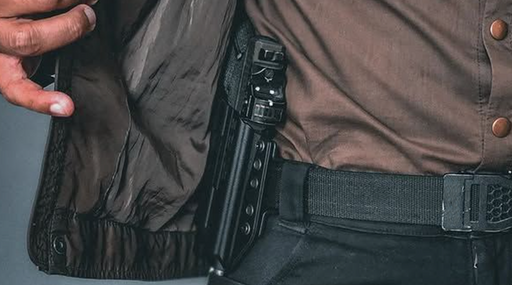Two days, five topics, one awesome learning experience
At least once every year, I try to place myself in a workshop with a high-profile instructor. It’s frustrating to get stagnant with some aspect of shooting; for me that’s usually speed where handguns are concerned. When I enrolled in a two-day pistol class by Kyle Defoor, I expected to find methods to improve my pistol shooting. While the class delivered in that regard, I also picked up unexpectedly useful information in a variety of other areas.
It’s not like I didn’t know we’d be covering empty-hand combatives, blade combatives, mindset, and casualty care. What made this course different is that now, two weeks later, I’ve retained and am prepared to confidently use several new skills in these departments. Other classes in the past have left me overwhelmed at the level of detail and finesse required for certain actions. While there’s no denying that those other courses better prepared me for this one, Defoor’s masterful use of learning theory made a big difference in absorbing and beginning to make the new information and skills my own.

Defoor, with a 10-year SEAL teams career including service in renowned SEAL Team 6, has a wealth of genuine combat experience, at virtually any range possible for a human with his feet on Planet Earth. He followed military service with even more years as an instructor and curriculum designer for the contracting company known as Blackwater at the time, as well as for an alphabet agency and numerous military units across the country. All that, and he’s a competitive runner and shooter as well.
With credit to his collaboration with a mentor, Thomas Kier, Defoor pointed out that, where possible, learning was presented in chunks of threes. We humans like to learn and retain information laid out in three parts. Here are some snippets of learning from each segment of the class.
Pistol shooting
An NRA B-8 target, with its six-inch bullseye, set at 25 yards would become a frenemy to most participants. We shot 10 rounds “cold” at the start, marking the score in the margin.
On the first repeat of this exercise, Defoor reminded the group of the importance of sight alignment. Of course, we all knew it’s a fundamental, but over-emphasis on front sight focus can lead to deviations in alignment that make a big difference at 25 yards and beyond. With newfound focus on sight alignment, it was a surprise to see my score jump 10 points. Many of my cohorts were seen jotting down improved scores too.
The next iteration of the drill was preceded by a segment of teaching on trigger press. Included here was something new to me; advice to wrap more of the finger around the trigger, up to the first joint. It felt awkward and took conscious effort. It was surprising to feel more control this way, more ease with keeping the sights aligned.
The last major segment of instruction with this drill, and the most in-depth, was regarding grip. Defoor is known for his fantastic recoil management. He credits his grip, placing emphasis on squeezing or pinching the gun hard with the thumb and forefinger of both hands, support hand angled forward with the index finger placed all the way to the front of the ground-facing side of the trigger guard. The three other fingers are relaxed. Clearly, this method works for him, and can be seen on his several videos online. My wrist reminded me of an old injury attempting this, so back to my old ways I went. Still, the other advice ramped my scores up consistently on day one.
Empty hand combatives
While I went for the shooting, I’ll admit this is the part of the course where I probably gained the most benefit. Many combatives courses are so focused on things being just so—the hand at this angle, the foot this far away from the opponent’s—that it’s impossible to recall all the details the next day. Not so in this class. Defoor laid out basics of how to use elbows and how to move. Like fencers, he had us pushing forward from a weighted rear foot. He proceeded to teach three strikes that utilize these skills.
Many advertised “self-defense” moves work as taught only when the opponent is passive. That only happens in the dojo! I left this class with a sense of confidence I’ve never had in terms of being able to get an attacker off me or out of bad-breath distance to make escape or gun response possible. Especially comforting is knowing what I learned works no matter the other person’s size. “Just throat punch the S.O.B.” is fine advice unless said throat is waaaay above my head!
Blade combatives
As expected from a Sayoc Kali practitioner, which Defoor is, traits of a desirable fighting knife and safe handling was covered before combat techniques. Here again, we learned three targets on the body on which to deliver the same, simple counterattack motion. Where exactly those are information to find out from attending the class or studying with another Sayoc instructor.
Another set of three taught here revealed the logic behind knife carry habits I’d heard from another former SEAL Team 6 member. “You need to be able to get to your blade, no matter where he has you,” Defoor said regarding fights that go to the ground or are similarly challenging. Carrying a blade, one can access low, midway, or high on the body insures the wearer can get to at least one. I left this portion of the course with new motivation to wear one of the neck knives that reside---well, not around my neck. Being metal-allergic, the dog tag chain is ruled out, as is anything that won’t break in a strangulation attempt.
Medical
In his presentation regarding stopping blood loss, Defoor covered three types of commercial tourniquets—the S.O.F., Combat Application Tourniquet, and SWAT-T. He also gave a jaw-dropping demo of improvising a tourniquet from students’ clothing. A jacket, a shoe, and a shoelace impressively combined to turn off circulation in a volunteer’s arm.
Sucking chest wounds and wounds requiring compression and/or non-tourniquet blood control were also covered. Instruction was peppered with riveting battlefield accounts. We learned about “leapfrogging” tourniquets if a wound lower on the extremity must have circulation turned off for more than 6-8 hours, as could well be the case for a civilian at a remote hiking or hunting location or during a mass casualty incident. By applying a new constrictor below the first one, always placed high on the limb, after a number of hours has transpired, so long as it’s still effective at stopping bleed-out, the severity of a potential amputation can be reduced.
Mindset
It’s been my experience that no one leaves the site of training by a former SEAL without a kick in the pants, motivation, inspiration, or something regarding mindset. And there’s usually a little Zen (not in the religious but the ephemeral sense) to be found in the mix. Here again, Defoor has grouped concepts into a triad. He drew a three-circle Venn diagram on a target, placing the words “Aware,” “Prepared,” and “Willing” in the cloverleaf.
Though awareness is a concept most readers will associate with situational awareness, here came the Zen. Self-awareness, with an objective look at oneself and the sequelae of one’s plans for the lives of others, was emphasized instead. “Preparation” has a focus on the skills to accomplish the mission one has set out to do. And “Willingness” is the ability to step into whatever gaps show up. “I can train you,” Defoor said, “but I can’t flip that willingness switch. You have to be the one to do that.”
There is a suicide crisis in the military and police communities. Our nation’s warrior class are a dedicated lot with support for being effective at work, but often caught short on the fronts that can somehow seem more natural for those not walking in that gap between criminal violence and civility. Defoor never mentioned this dilemma per se; he did one better by reframing it in a segment on “living well.” Here, he broke from the three-part pattern to add a fourth. Minding and addressing imbalances of 1) ego, 2) money, 3) relationships, and 4) substances, he said, is really the key. It’s an important, digestible, non-patronizing message I wish more warriors could hear.
Get thee to a class
Defoor Performance Shooting classes are known to fill very fast. A couple have just been added to the calendar. Anyone who has as part of their central mission protecting themselves, their family, community, or nation can benefit. Substantial equipment prep is necessary; plan well in advance if you’re thinking about enrolling.
About Eve:
Eve Flanigan is a defensive shooting and concealed carry instructor living in the American Southwest. Today she works full time as an instructor and writer in the gun industry. Flanigan loves helping new and old shooters alike to develop the skills needed to keep themselves and their loved ones safe.
























Leave a comment
1 comment
Really appreciate the detailed write-up on Kyle Defoor’s class — love how it breaks down both mindset and practical application. Training like this is invaluable, especially when paired with quality gear. We’re big fans of continuing education like this at Shooters Supply. Great post! https://shooterssupply.com/